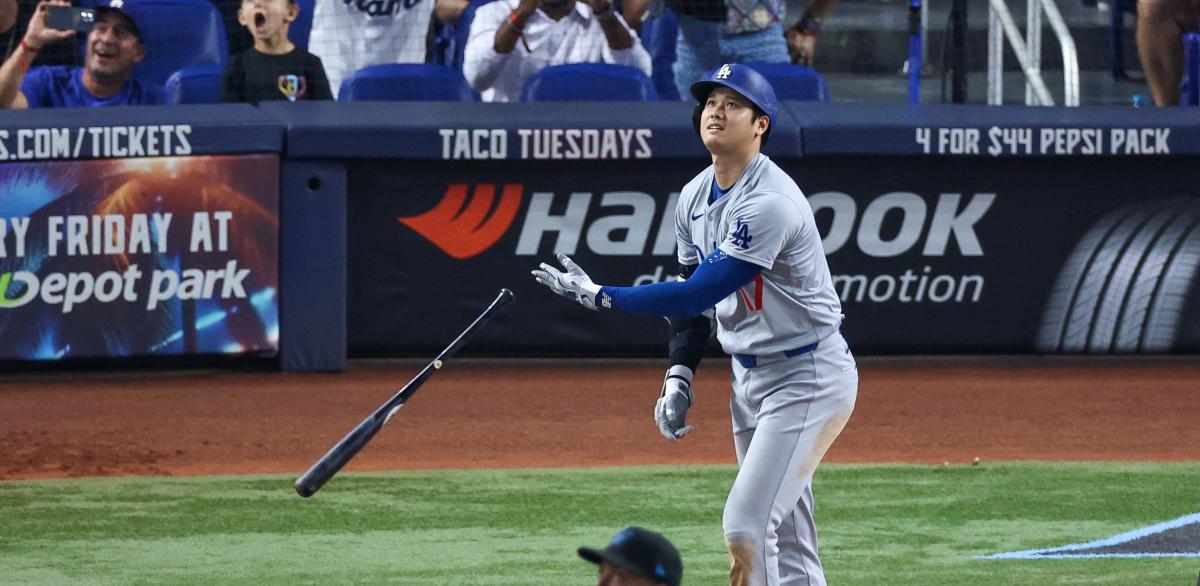ECR stands for “Ranking of expert consensus,“which is the average ranking of the fantasy football industry and is typically comparable to ADP (which varies from site to site). This ongoing positional series shall highlight some major differences between ECR and my own ranks.
Go here for quarterbacks.
Breece Hall, New York Jets
ECR:RB3 vs. My rank:RB2
Hall averaged the third-most 0.5 PPR fantasy points (17.3) in Week 5 of last season, as he began seeing full snaps while returning from ACL surgery. Only Christian McCaffrey had more fantasy points during that span, despite Hall playing for a New York offense that allowed the second-fewest yards per play (4.3). The Jets’ quarterbacks were truly abysmal without Aaron Rodgers, as New York averaged just 15.8 points per game (fourth-fewest) while Hall had the 43rd-most red-zone rushes; the Jets somehow managed just one carry inside the five-yard line and none on the goal line last season. Hall had just 3.3 expected rushing touchdowns — but remained a fantasy star.
He is a special back who somehow leads all RBs in YPC after contact And yards per route run since entering the league. Hall has a better YPRR ratio than CMC despite playing in a bottom-three situation and recovering from major knee surgery.
Running backs historically show real improvement in Year 2 after ACL surgery, and Hall led all RBs in receptions last season. Hall is feeling like his old self again, and a returning Rodgers would be a big improvement at quarterback. The Jets have a dominant defense and have made up for their poor offensive line early in the draft and through free agency. Hall averaged the most fantasy points when his team led and had the second-most weighted odds as a favorite last season, and the Jets are favored in 14 of 17 games through 2024.
Given the lack of Tier 1 RBs, Hall is the #2 player on my board in 0.5 PPR leagues, but his ECR is 7th. I’m closer to moving Hall to RB1 than RB3.
Derrick Henry, Baltimore Ravens
ECR: RB8 vs. My rank: RB6
Henry’s declining numbers in the last two seasons (when he still scored 25 TDs) were more a product of a poor Titans offense than Henry’s performance; he remained explosive and ranked in the top three in YPC in contact against stacked boxes in 2023. Now 30 years old, Henry’s touches were limited early in his career and he’s also just built differently. Henry’s snap share dropped to 53% last season, but he still led the league for the fourth time in five years in an offense that allowed a meager 4.9 yards per play.
It’s hard to overstate how big an upgrade Henry saw when he left Tennessee for Baltimore this offseason. Henry has run in more than 120 eight-man boxes over the past three seasons than any other RB, while Lamar Jackson helped a depleted Ravens RB group score the fourth-most fantasy points last year. Gus Edwards has benefited from a ton of short-yardage touchdowns, and Henry’s style seems to be a good fit for Baltimore’s offense; his career YPC has jumped more than a full yard from shotgun and pistol (5.1 YPC).
Henry has averaged nearly twice as many 0.5 PPR fantasy points per win over his entire career, and no team led by more than the Ravens last season. Henry has averaged 98.4 rushing yards (5.1 YPC) with 65 touchdowns in 59 wins compared to 49.1 rushing yards (4.0) and just 15 scores in 44 losses over his career. Baltimore is projected to win 11-plus games in 2024. The Ravens would love to give Henry 300 carries on an offense that averaged 28.4 points per game last year, and The King remains motivated.
Henry’s ADP is no longer a gift like it was earlier this summer, but he’s still undervalued at the draft tables.
De’Von Achane, Miami Dolphins
ECR:RB11 against My rank:RB7
Achane averaged the fourth-most 0.5 PPR fantasy points (16.5) last season despite playing five or fewer snaps in two games and never surpassing 18 carries (or 38 snaps). He had the highest YPC (7.8) and rushing DVOA of any running back in NFL history. Achane’s healthy full season pace was 1,541 yards from scrimmage and 17 touchdowns, despite sharing the backfield with a RB leading the NFL in rushing TDs.
Achane averaged 115 yards from scrimmage while playing 40% of the snaps. He led the league in yards after contact per touch among many other rushing categories. Achane outpaced Mostert and had the same number of first-read targets as Rachaad White in just nine healthy games as a rookie, so he has legitimate receiving upside as well.
Even with a healthy Raheem Mostert, Achane averaged more chances per game (15.1) than Jahmyr Gibbs (14.0) with David Montgomery. Mike McDaniel expects a more muscular Achane to play a bigger role in Year 2, and the 32 years old Mostert has a extended Injury history. Miami’s running backs accumulated 50+ more 0.5 PPR points last season than any RB group since 2020, and a healthy Achane could explode into an expanded role.
De’Von Achane is 1 of 7 Rookie RBs since 2009 to hit 3+ FPOE/g (Fantasy Pts above expectations)
The 6 RBs before him hit 20+ PPG in their 2nd year in the NFL
Achane has the highest FPOE/g season for a rookie RB ever and is entering his 2nd season. Plan accordingly photo.twitter.com/PT2DwKrCat
— Ron Stewart (@RonStewart_) July 19, 2024
The argument against Achane largely comes down to health, as he costs a top 30 pick after playing just nine full games and dealing with multiple injuries as a rookie. He’s 5-9 and 188 pounds, so asking for 250+ touches might be a bridge too far.
Achane is undoubtedly a riskier fantasy pick whose historical efficiency will surely decline, but he also has a league-winning upside given his individual skills and the likelihood of Mostert being out. Even if Achane misses games, there are few players who can win your week early if they are healthy.
Achane is a steal in round 3.
James Conner, Arizona Cardinals
ECR:RB21 against My rank:RB13
It’s usually best not to target 29-year-old running backs with a history of missing games, but Conner is ranked too low due to injury concerns and Trey Benson. Conner scored the most RB fantasy points in Week 13 last season and finished third in rushing yards above expectations, behind only Christian McCaffrey and Achane. Conner is an underrated three-down back who quietly led all RBs in 20+ yard rushes last season.
The Cardinals were a top-10 offense coming into Week 10 following Kyler Murray’s return last season, when Arizona’s rushing attack led the NFL in YPC (5.3) and EPA per attempt. Murray should improve in his second year back from surgery, and the Cardinals added weapon Marvin Harrison Jr. early in the draft. Trey McBride figures to be a star at tight end, and Arizona snapped the ball with the sixth-most seconds on the clock last season (despite shaky QB play before Murray returned).
Benson could end up being a nice insurance policy for Conner’s fantasy managers, but the third-round pick is currently in contention for Arizona’s RB2 job, had a low athletic rating, and probably won’t steal many touches. Conner will likely miss a few more games this season, but it can’t be stressed enough that ALL running backs carry a significant injury risk. And Conner has a real shot at being a top-five fantasy back if he’s healthy.
You don’t even have to draft Conner where I have him ranked as he is clearly the best target in the “RB dead zone”.
Tyjae Spears, Tennessee Titans
ECR:RB32 vs. My rank:RB25
Spears was the only RB to force 25+ tackles on fewer than 100 carries last season, and he ranked third among backs in first-read targets as a rookie. Spears recorded the fourth-most scrimmage yards (1,837) his senior year in college, where he thrived out of the shotgun; Brian Callahan’s Bengals ranked third in shotgun rate last season.
Yards after contact/att (college career)
Tyjae Spears: 4.54
Bijan Robinson: 4.40
Jonathan Brooks: 4.13
Audric Estimate: 4.05
Trey Benson: 3.97
De’Von Achane: 3.93
Kendre Miller: 3.83
Bucky Irving: 3.81
Braelon Allen: 3.66
Zach Charbonnet: 3.54
Gibbs Year: 3.53
Blake Corum: 3.04— Football Insights 📊 (@fball_insights) January 25, 2024
Meanwhile, his competition for touches has gone from Derrick Henry to Tony Pollard. Pollard has admitted he wasn’t fully healthy following tightrope surgery until midway through last season, and there’s no doubt he’s improved in the latter stages. Still, his second-half numbers were disappointing, with Pollard somehow finishing as just the RB22 (11.5 FPPG) despite seeing the league’s second-most red-zone touches (72) behind a strong offensive line. Spears had more targets and 24% more receiving yards while running 75 fewer routes than Pollard last year.
Spears may not have a long NFL career, but he’s a much better option than Pollard in 2024, when their ADPs should be reversed.



